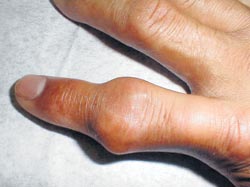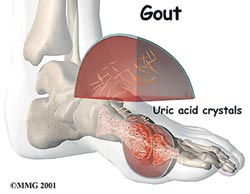Down with a bout of Gout!
By Dr. Kaleel Cassim
Gout has been known for more than 2000 years. It can affect men of any age. It is less common in women and then only occurs after menopause. Luckily, gout is probably the rheumatic disease for which there is the most satisfactory treatment.
- What is gout and what
causes it?
The old adage that eating and drinking too much causes gout has now been proved wrong, although it is true that if you over-indulge in alcohol - especially beer and wine - or food, attacks of gout are more likely.
People get gout because there is something wrong with the chemical processes of their body. Urate (which we all have in our blood) can build up and form crystals in the joints and cause them to feel intensely painful. This defect is usually inherited from a parent or grandparent. Gout runs in families.
The joints are not the only part of the body to be affected. Crystals may appear under the skin, including sometimes on the ear. They look like little white pimples and are called 'tophi'.
 |
- What is the role of urate?
Urate forms in the blood of healthy people as a breakdown product of various chemical processes. Normally the body rids itself of any excess urate through the kidneys into the urine. However, in people who are prone to gout this does not happen fast enough, so the level of urate builds up. An inherited tendency to gout is the most common cause of the condition. Other causes include kidney disease, in which there tends to be a higher level of urate in the blood because the kidneys do not get rid of it (excrete it) properly. Or, certain other diseases produce too many cells (for example, white blood cells in some blood disorders). These cells release urate when they are broken down after the body has finished with them and this causes an increase in the urate level.
Urate in the bloodstream travels in the clear part of the blood (the plasma) in the form of a salt. The plasma urate level normally tends to be higher in men than women.
However, even if the level is high, it will not necessarily lead to gout. Close relatives of people who have gout may have too much urate in their bodies yet never have a single attack of gout in their lives. Certain tablets - such as diuretics, which drain water from the body, and are used to treat heart disease or high blood pressure - increase urate levels and may cause gout.
- What is an acute attack like?
This is the most painful of all forms of arthritis or rheumatism. Attacks usually start during the night, often with pain in the big toe. The toe becomes very red, swollen and extremely tender. Even someone bumping into the bed can cause pain. It sometimes resembles a boil near the joint and it can be difficult even for a rheumatologist to tell whether the trouble is gout or inflammation in a bunion. The inflammation is caused by urate crystals being shed into the joints. Other joints - the knee, the elbow or the wrist, for example - may be afflicted.
 |
If you are a person who has had gout before and you injure or bruise a joint which then becomes more painful, or takes longer than expected to get better, always see your rheumatologist. You may have triggered an attack of gout.
Apart from injury, other things such as fatigue, worry or illness can start an attack. Sometimes an operation (even a minor one like having a tooth out) can bring on an attack a few days later. Excessive eating and drinking can be another cause of attacks.
- What are the long-term risks?
The first few attacks of gout do no permanent damage to the joints and you can expect a complete recovery, leaving you with a normal joint. It is only when a joint is repeatedly attacked by gout - a rare thing nowadays - that the urate crystals damage the joint and so start off long-term (chronic) arthritis. In mild cases the attacks are often so infrequent - with intervals of many years between them - that permanent damage is unlikely ever to occur.
Gout is occasionally associated with high blood pressure and too much fat in the blood (hyperlipidaemia). Also, stones may form in the kidney if gout is untreated.
- How is gout diagnosed?
Your rheumatologist may suggest the following investigations:
- A blood test
This measures the amount of urate in the blood (as plasma urate). A raised level strongly supports the diagnosis of gout; but unfortunately the level may also be high in the other conditions already mentioned, and also in healthy people who do not have gout - especially if they are overweight. Alternatively, sometimes the level of urate can be normal even during an acute attack of gout.
- Examination of joint fluid
Synovial fluid can be taken from a joint through a needle. It is then examined under a microscope, where any crystals of urate will be quickly spotted. If crystals are present, the diagnosis of gout is proved. This test, which usually causes no more discomfort than a blood test, is particularly useful when gout starts in an unusual way. For example, gout can occasionally mimic another type of rheumatic disease such as rheumatoid arthritis.
- X-rays of joints
X-rays might be taken but, as they often appear normal, they may not help in the diagnosis.
Next month: Treatment
and prevention.
(The writer is Consultant Rheumatologist, Sri Jayewardenepura General Hospital) |


